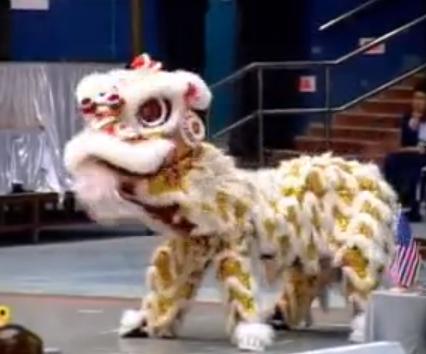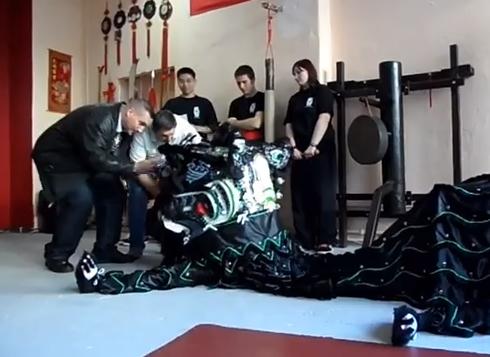Chinese Lion Dance
 Lion Dance is the most popular folk dance in China, it originated in China more than a thousand years ago. Lion dances are also usually more popular than dragon dances. Chinese lion dances are broadly categorized into two major styles. Southern and Northern. The northern lion dance is usually involve acrobatic style and used mainly as entertainment for the imperial court while the southern lion dance is performed usually as a special ceremony in order to exorcise evil spirits and also to attract fortune and luck.
Lion Dance is the most popular folk dance in China, it originated in China more than a thousand years ago. Lion dances are also usually more popular than dragon dances. Chinese lion dances are broadly categorized into two major styles. Southern and Northern. The northern lion dance is usually involve acrobatic style and used mainly as entertainment for the imperial court while the southern lion dance is performed usually as a special ceremony in order to exorcise evil spirits and also to attract fortune and luck.
Cai Qing Performance
The lion dance usually performs during the Chinese New Year, Lantern Festival and other important or popular events such as opening business ceremony, Cap Go Meh Festival and wedding ceremony. During the Chinese New Year, you can often see lion dances that are performing “cai qing (plucking the green)” in front of the shops and houses. The ‘green’ here refers to vegetable leaves that are often tied with a piece of string and has a red packet attached containing money. This ‘green’ is hung above the door of the house or shop and the lion will approach it and eat both the green and the red packet (Hung pao in Chinese).
After successfully get the green, the lion will lye on the floor and chew it. Some of the leaves will be spit out, signifying that there will be abundance of everything in the coming year. The lions are normally awarded with oranges, mandarins/tangerines or other food that has lucky and auspicious symbolic meaning. Lion dances are often accompanied by a fan bearer, the funny, smiling and happy person or ‘uncle’, the latter being the God of Smiles.
Since the ghosts, monsters and evil spirits are afraid of loud noises, the dance has also become a natural complement to the fire crackers’ noise. Other than that, clashing cymbals, drums and a gong usually accompany this lively scene.
Eye Dotting Ceremony
 In traditional southern lion dance, before the ‘lions’ do their performances, the ‘animal’ must be blessed by an eye opening or eye dotting ceremony. The eye opening ceremony is the ceremony where the eyes, ears, nose, mouth, leg, forehead and the rest of the necessary parts of the lion is dotted by a special trained person. This is done to awaken the spirit of the lion before it is being used in the lion dance. In other words, they bring down the positive spirit from the heaven to the lion and give it life.
In traditional southern lion dance, before the ‘lions’ do their performances, the ‘animal’ must be blessed by an eye opening or eye dotting ceremony. The eye opening ceremony is the ceremony where the eyes, ears, nose, mouth, leg, forehead and the rest of the necessary parts of the lion is dotted by a special trained person. This is done to awaken the spirit of the lion before it is being used in the lion dance. In other words, they bring down the positive spirit from the heaven to the lion and give it life.
Different schools has their different way of conducting this ceremony. Most of the ceremony usually begins with the lion costume being laid down in front of the ancestral altar, its eyes are securely shut and its mouth is tightly closed. There are drum, gong and cymbals that are playing softly and steadily in the background. Traditionally, a monk/priest present begins the ceremony chanting of prayers to the heavenly gods and summon the soul and spirit down from the heaven into the lion. After this, the appointed person will dot the eyes of the lion with symbolic blood or red ink-cinnabar.
The red color is used because the color is associated with fire, life and good luck or fortune. The rooster is used because the animal symbolizes maleness and positive yang element, rooster also represents power and life. The first part of the lion to be dotted is the mirror on its forehead, then the eyes (for sight), followed by its nose, tongue, ears, horn, back of head, spine and the tail. A red ribbon is then tied on the lion’s horn to symbolize courage as well as to signify that this lion is tamed. The red ribbon is also used as a reminder to the lion that the lion has to do only good deeds. The mirror is believed to expel negative energy or spirits. With this mirror, the evil spirits would be frightened by their own appearance and hence would disappear.
When the lion awakens, its eyes will blink and moves slowly, followed by its mouth, ears (flicker) and then the body. Meanwhile, the drum, gong and cymbals start to get louder and firecrackers are then set off. From here, as usual, the lion dance begins with three bows facing the altar; left, right and center, after that the lion will continue doing its traditinal dance. According to the tradition, a lion used in any event without being awakened or blessed, it will bring bad luck and misfortune.
A group of lion dancers normally consist of about 10 people and the performers are often kung fu practitioners. The lion dance combines history, art and kung fu moves. The appearance of the lion, its fur and the costume are often created according to the five elements theory, the bagua and the feng shui to further strengthen its positive impact.
When two lions from different clans encounter aech other, each of them must lower its head as a sign of respect.
Copyright © 2009 Game Frog
Home | Contact | Disclaimer | Privacy Policy